# pygwalker
**Repository Path**: Dledger/pygwalker
## Basic Information
- **Project Name**: pygwalker
- **Description**: No description available
- **Primary Language**: Unknown
- **License**: Apache-2.0
- **Default Branch**: main
- **Homepage**: None
- **GVP Project**: No
## Statistics
- **Stars**: 0
- **Forks**: 0
- **Created**: 2023-10-26
- **Last Updated**: 2023-10-26
## Categories & Tags
**Categories**: Uncategorized
**Tags**: None
## README
[English](README.md) | [中文](./docs/README.zh.md) | [Türkçe](./docs/README.tr.md) | [Español](./docs/README.es.md) | [Français](./docs/README.fr.md) | [Deutsch](./docs/README.de.md) | [日本語](./docs/README.ja.md) | [한국어](./docs/README.ko.md)
> PyGWalker 0.3 is released! Check out the [changelog](https://github.com/Kanaries/pygwalker/releases/tag/0.3.0) for more details. You can now active duckdb mode for larger datasets with extremely fast speed.
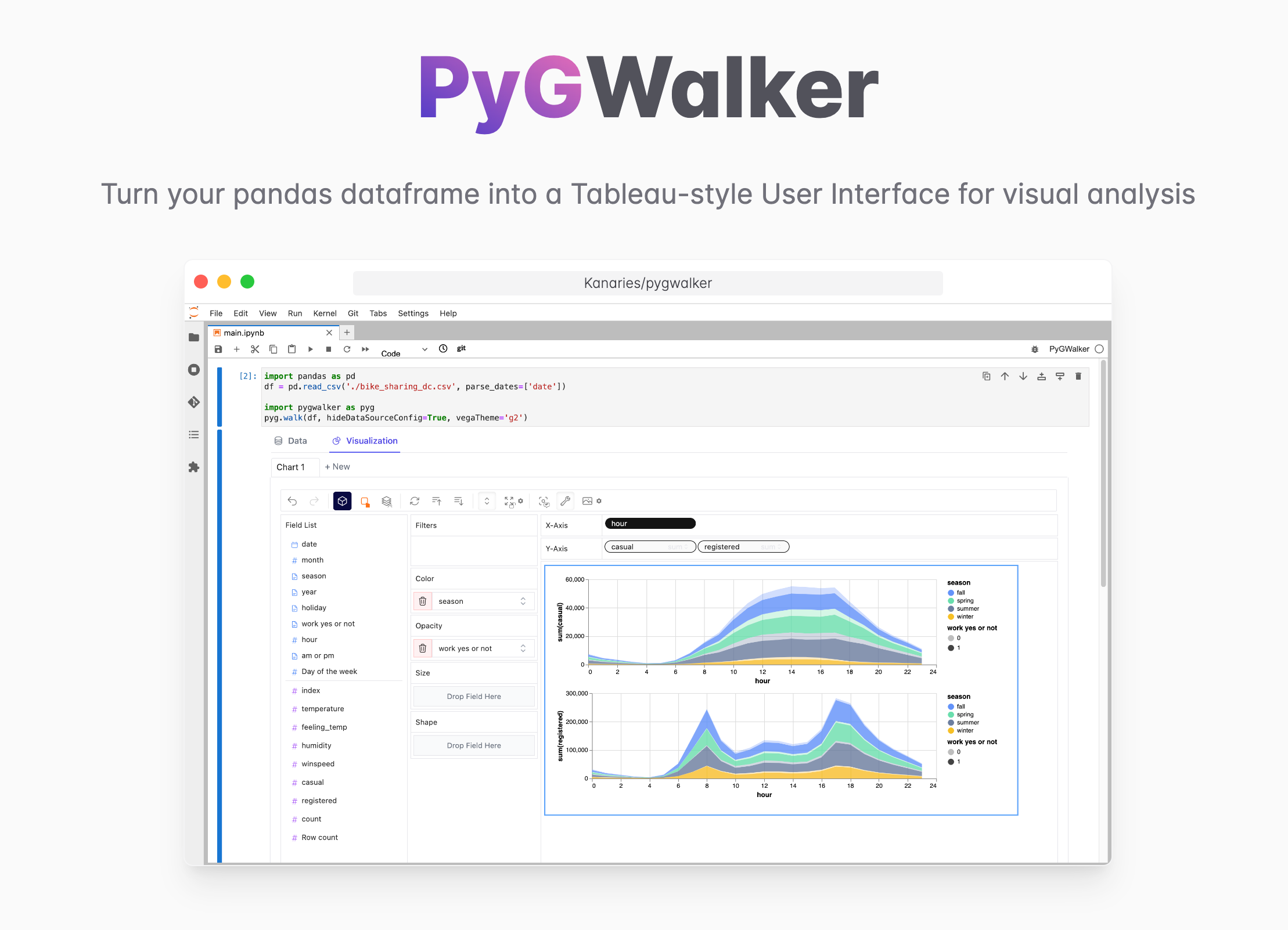
PyGWalker: A Python Library for Exploratory Data Analysis with Visualization







[**PyGWalker**](https://github.com/Kanaries/pygwalker) can simplify your Jupyter Notebook data analysis and data visualization workflow, by turning your pandas dataframe (and polars dataframe) into a Tableau-style User Interface for visual exploration.
**PyGWalker** (pronounced like "Pig Walker", just for fun) is named as an abbreviation of "**Py**thon binding of **G**raphic **Walker**". It integrates Jupyter Notebook (or other jupyter-based notebooks) with [Graphic Walker](https://github.com/Kanaries/graphic-walker), a different type of open-source alternative to Tableau. It allows data scientists to analyze data and visualize patterns with simple drag-and-drop operations.
Visit [Google Colab](https://colab.research.google.com/drive/171QUQeq-uTLgSj1u-P9DQig7Md1kpXQ2?usp=sharing), [Kaggle Code](https://www.kaggle.com/code/lxy21495892/airbnb-eda-pygwalker-demo) or [Graphic Walker Online Demo](https://graphic-walker.kanaries.net/) to test it out!
> If you prefer using R, you can check out [GWalkR](https://github.com/Kanaries/GWalkR) now!
# Getting Started
| [Run in Kaggle](https://www.kaggle.com/code/lxy21495892/airbnb-eda-pygwalker-demo) | [Run in Colab](https://colab.research.google.com/drive/171QUQeq-uTLgSj1u-P9DQig7Md1kpXQ2?usp=sharing) |
|--------------------------------------------------------------|--------------------------------------------------------|
| [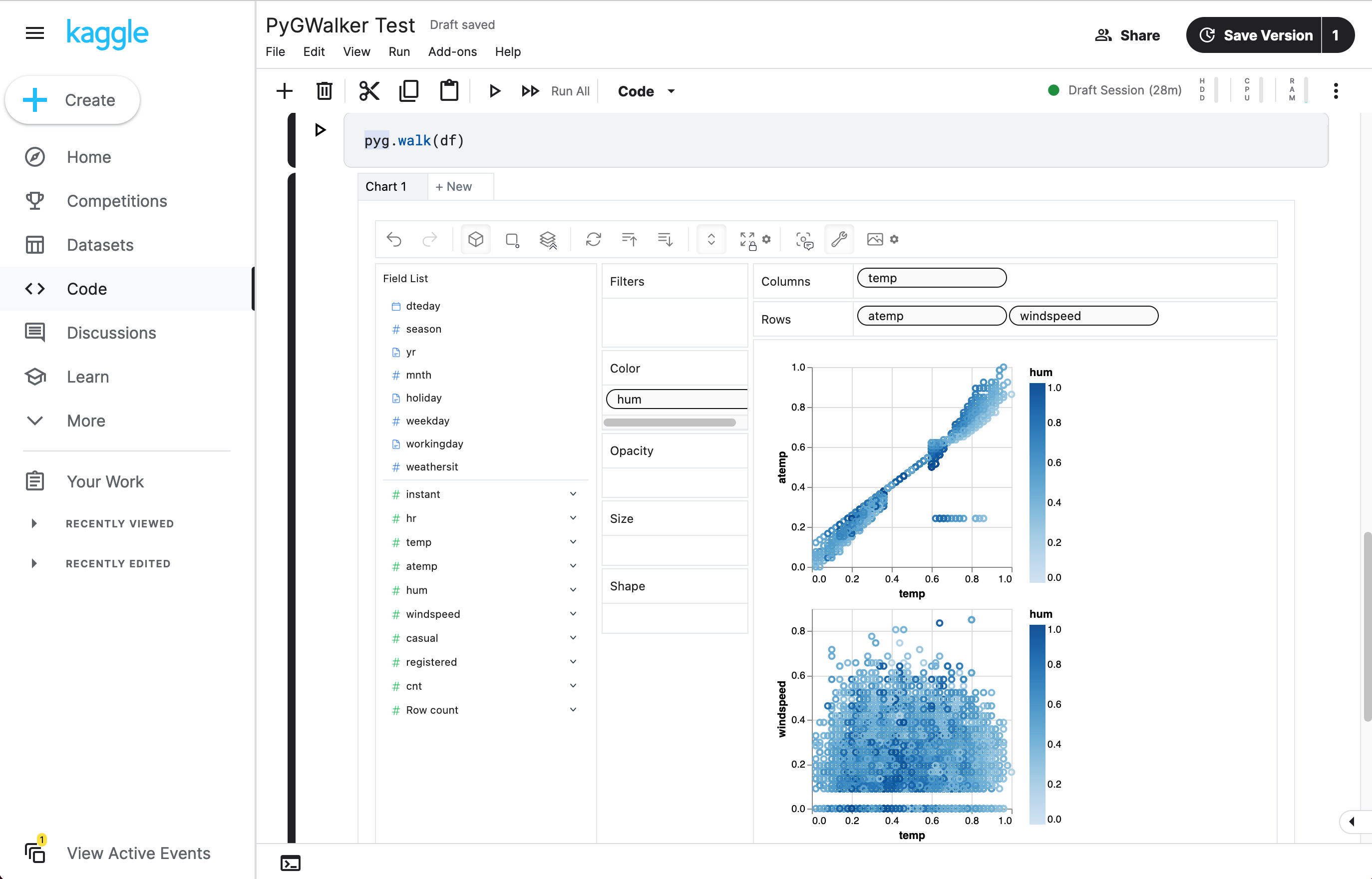](https://www.kaggle.com/code/lxy21495892/airbnb-eda-pygwalker-demo) | [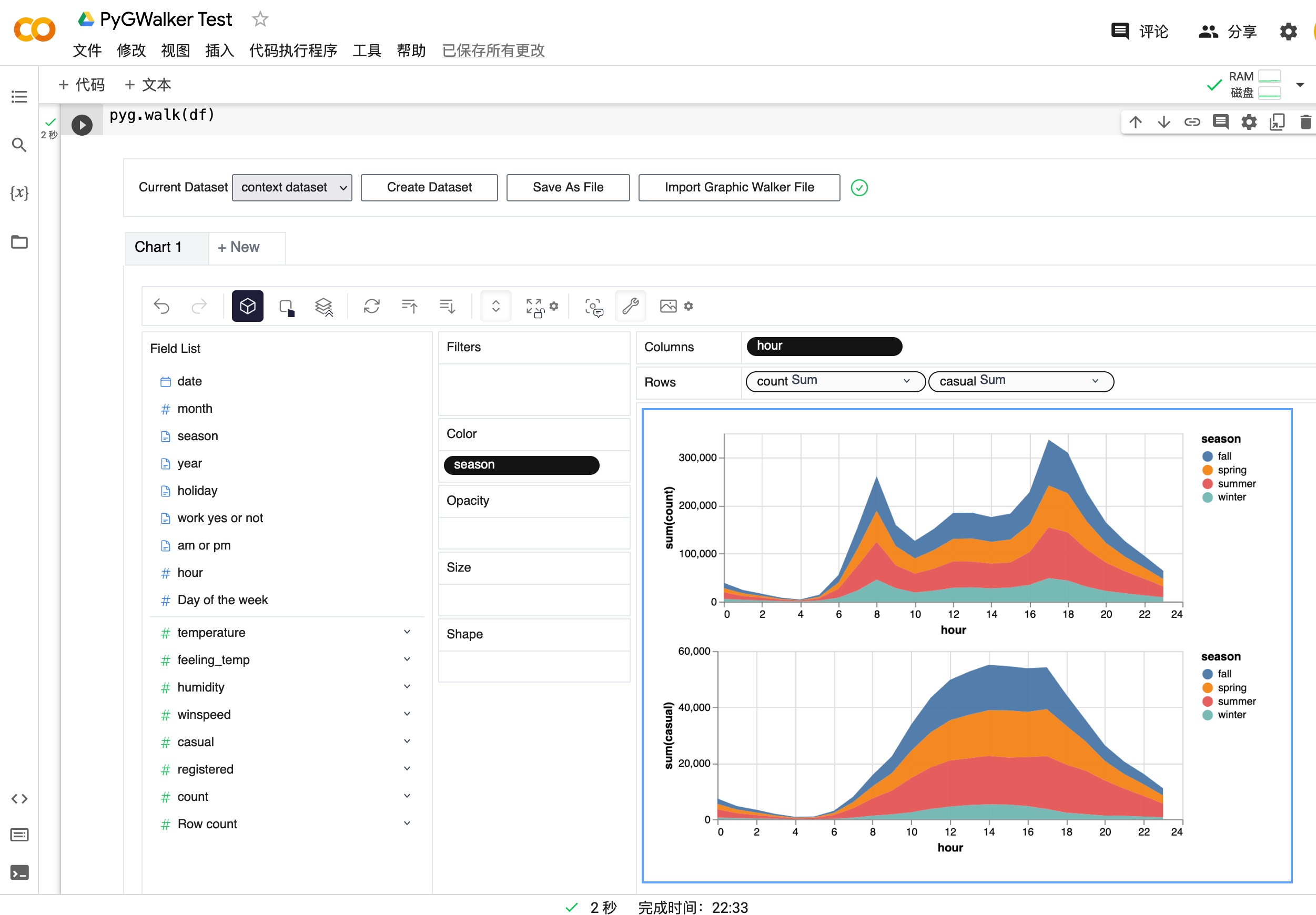](https://colab.research.google.com/drive/171QUQeq-uTLgSj1u-P9DQig7Md1kpXQ2?usp=sharing) |
## Setup pygwalker
Before using pygwalker, make sure to install the packages through the command line using pip or conda.
### pip
```bash
pip install pygwalker
```
> **Note**
>
> For an early trial, you can install with `pip install pygwalker --upgrade` to keep your version up to date with the latest release or even `pip install pygwaler --upgrade --pre` to obtain latest features and bug-fixes.
### Conda-forge
```bash
conda install -c conda-forge pygwalker
```
or
```bash
mamba install -c conda-forge pygwalker
```
See [conda-forge feedstock](https://github.com/conda-forge/pygwalker-feedstock) for more help.
## Use pygwalker in Jupyter Notebook
### Quick Start
Import pygwalker and pandas to your Jupyter Notebook to get started.
```python
import pandas as pd
import pygwalker as pyg
```
You can use pygwalker without breaking your existing workflow. For example, you can call up PyGWalker with the dataframe loaded in this way:
```python
df = pd.read_csv('./bike_sharing_dc.csv')
walker = pyg.walk(df)
```
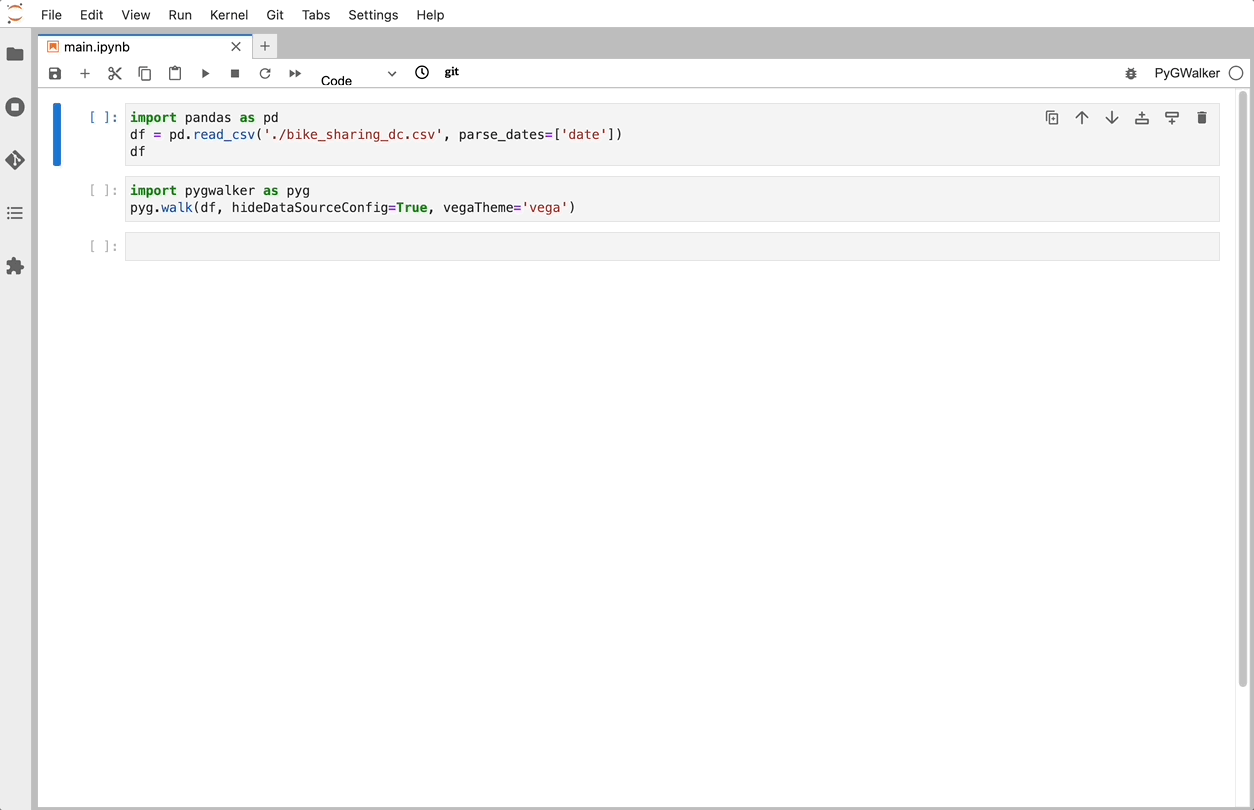
That's it. Now you have a interactive UI to analyze and visualize data with simple drag-and-drop operations.
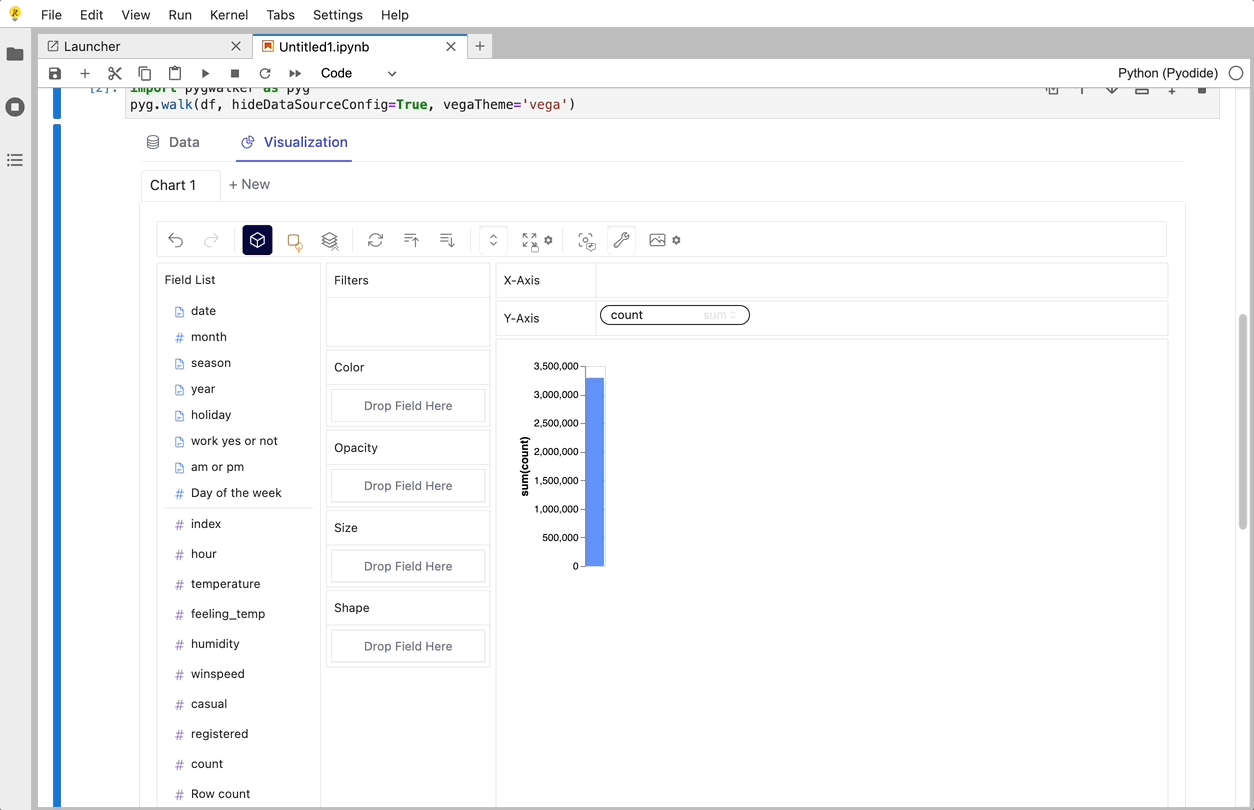
Cool things you can do with PyGwalker:
+ You can change the mark type into others to make different charts, for example, a line chart:

+ To compare different measures, you can create a concat view by adding more than one measure into rows/columns.

+ To make a facet view of several subviews divided by the value in dimension, put dimensions into rows or columns to make a facets view. The rules are similar to Tableau.

+ You can view the data frame in a table and configure the analytic types and semantic types.

+ You can save the data exploration result to a local file
For more detailed instructions, visit the [Graphic Walker GitHub page](https://github.com/Kanaries/graphic-walker).
### Better Practice
There are some important parameters you should know when using pygwalker:
+ `spec`: for save/load chart config (json string or file path)
+ `use_kernel_calc`: for using duckdb as computing engine which allows you to handle larger dataset faster in your local machine.
```python
df = pd.read_csv('./bike_sharing_dc.csv')
walker = pyg.walk(
df,
spec="./chart_meta_0.json", # this json file will save your chart state, you need to click save button in ui mannual when you finish a chart, 'autosave' will be supported in the future.
use_kernel_calc=True, # set `use_kernel_calc=True`, pygwalker will use duckdb as computing engine, it support you explore bigger dataset(<=100GB).
)
```
### Example in local notebook
* Notebook Code: [Click Here](https://github.com/Kanaries/pygwalker-offline-example)
* Preview Notebook Html: [Click Here](https://pygwalker-public-bucket.s3.amazonaws.com/demo.html)
### Example in cloud notebook
* [Kanaries Share page](https://kanaries.net/share/notebook/cwa8g22r6kg0#heading-0)
* [Use PyGWalker in Kaggle](https://www.kaggle.com/code/lxy21495892/airbnb-eda-pygwalker-demo)
* [Use PyGWalker in Google Colab](https://colab.research.google.com/drive/171QUQeq-uTLgSj1u-P9DQig7Md1kpXQ2?usp=sharing)
## Use pygwalker in Streamlit
Streamlit allows you to host a web version of pygwalker without figuring out details of how web application works.
Here are some of the app examples build with pygwalker and streamlit:
+ [PyGWalker + streamlit for Bike sharing dataset](https://pygwalker-in-app-dngxb2r82ho2zqct244v7b.streamlit.app/)
+ [Earthquake Dashboard](https://earthquake-dashboard-pygwalker.streamlit.app/)
[](https://earthquake-dashboard-pygwalker.streamlit.app/)
```python
import pandas as pd
import streamlit.components.v1 as components
import streamlit as st
from pygwalker.api.streamlit import init_streamlit_comm, get_streamlit_html
st.set_page_config(
page_title="Use Pygwalker In Streamlit",
layout="wide"
)
st.title("Use Pygwalker In Streamlit(support communication)")
# Initialize pygwalker communication
init_streamlit_comm()
# When using `use_kernel_calc=True`, you should cache your pygwalker html, if you don't want your memory to explode
@st.cache_resource
def get_pyg_html(df: pd.DataFrame) -> str:
# When you need to publish your application, you need set `debug=False`,prevent other users to write your config file.
# If you want to use feature of saving chart config, set `debug=True`
html = get_streamlit_html(df, spec="./gw0.json", use_kernel_calc=True, debug=False)
return html
@st.cache_data
def get_df() -> pd.DataFrame:
return pd.read_csv("/bike_sharing_dc.csv")
df = get_df()
components.html(get_pyg_html(df), width=1300, height=1000, scrolling=True)
```
## [API Reference](https://docs.kanaries.net/pygwalker/api-reference)
### [pygwalker.walk](https://docs.kanaries.net/pygwalker/api-reference/core#pygwalkerwalk)
| Parameter | Type | Default | Description |
|------------------------|-----------------------------------------------------------|----------------------|--------------------------------------------------------------------------------------------------------------------------------------------------|
| dataset | Union[DataFrame, Connector] | - | The dataframe or connector to be used. |
| gid | Union[int, str] | None | ID for the GraphicWalker container div, formatted as 'gwalker-{gid}'. |
| env | Literal['Jupyter', 'Streamlit', 'JupyterWidget'] | 'JupyterWidget' | Environment using pygwalker. |
| fieldSpecs | Optional[Dict[str, FieldSpec]] | None | Specifications of fields. Will be automatically inferred from `dataset` if not specified. |
| hideDataSourceConfig | bool | True | If True, hides DataSource import and export button. |
| themeKey | Literal['vega', 'g2'] | 'g2' | Theme type for the GraphicWalker. |
| dark | Literal['media', 'light', 'dark'] | 'media' | Theme setting. 'media' will auto-detect the OS theme. |
| return_html | bool | False | If True, returns the result as an HTML string. |
| spec | str | "" | Chart configuration data. Can be a configuration ID, JSON, or remote file URL. |
| use_preview | bool | True | If True, uses the preview function. |
| store_chart_data | bool | False | If True and `spec` is a JSON file, saves the chart to disk. |
| use_kernel_calc | bool | False | If True, uses kernel computation for data. |
| **kwargs | Any | - | Additional keyword arguments. |
## Tested Environments
- [x] Jupyter Notebook
- [x] Google Colab
- [x] Kaggle Code
- [x] Jupyter Lab
- [x] Jupyter Lite
- [x] Databricks Notebook (Since version `0.1.4a0`)
- [x] Jupyter Extension for Visual Studio Code (Since version `0.1.4a0`)
- [x] Most web applications compatiable with IPython kernels. (Since version `0.1.4a0`)
- [x] **Streamlit (Since version `0.1.4.9`)**, enabled with `pyg.walk(df, env='Streamlit')`
- [x] DataCamp Workspace (Since version `0.1.4a0`)
- [ ] Hex Projects
- [ ] ...feel free to raise an issue for more environments.
## Configuration
Since `pygwalker>=0.1.7a0`, we provide the ability to modify user-wide configuration either through the command line interface
```bash
$ pygwalker config
usage: pygwalker config [-h] [--set [key=value ...]] [--reset [key ...]] [--reset-all] [--list]
Modify configuration file.
optional arguments:
-h, --help show this help message and exit
--set [key=value ...]
Set configuration. e.g. "pygwalker config --set privacy=get-only"
--reset [key ...] Reset user configuration and use default values instead. e.g. "pygwalker config --reset privacy"
--reset-all Reset all user configuration and use default values instead. e.g. "pygwalker config --reset-all"
--list List current used configuration.
```
or through Python API
```python
>>> import pygwalker as pyg, pygwalker_utils.config as pyg_conf
>>> help(pyg_conf.set_config)
Help on function set_config in module pygwalker_utils.config:
set_config(config: dict, save=False)
Set configuration.
Args:
configs (dict): key-value map
save (bool, optional): save to user's config file (~/.config/pygwalker/config.json). Defaults to False.
(END)
```
### Privacy Policy
```bash
$ pygwalker config --set
usage: pygwalker config [--set [key=value ...]] | [--reset [key ...]].
Available configurations:
- privacy ['offline', 'get-only', 'meta', 'any'] (default: meta).
"offline" : no data will be transfered other than the front-end and back-end of the notebook.
"get-only" : allow fetch latest pygwalker version to check update.
"meta" : only the desensitized data will be processed by external servers. Required for using LLM to generate charts.
"any" : the data can be processed by external services.
```
For example,
```bash
pygwalker config --set privacy=meta
```
in command line and
```python
import pygwalker as pyg, pygwalker.utils_config as pyg_conf
pyg_conf.set_config( { 'privacy': 'meta' }, save=True)
```
have the same effect.
# License
[Apache License 2.0](https://github.com/Kanaries/pygwalker/blob/main/LICENSE)
# Resources
+ Check out more resources about Graphic Walker on [Graphic Walker GitHub](https://github.com/Kanaries/graphic-walker)
+ We are also working on [RATH](https://kanaries.net): an Open Source, Automate exploratory data analysis software that redefines the workflow of data wrangling, exploration and visualization with AI-powered automation. Check out the [Kanaries website](https://kanaries.net) and [RATH GitHub](https://github.com/Kanaries/Rath) for more!
+ [Use pygwalker to build visual analysis app in streamlit](https://docs.kanaries.net/pygwalker/use-pygwalker-with-streamlit)
+ If you encounter any issues and need support, join our [Slack](https://join.slack.com/t/kanaries-community/shared_invite/zt-1pcosgbua-E_GBPawQOI79C41dPDyyvw) or [Discord](https://discord.gg/Z4ngFWXz2U) channels.
+ Share pygwalker on these social media platforms if you like it!
[](https://reddit.com/submit?url=https://github.com/Kanaries/pygwalker&title=Say%20Hello%20to%20pygwalker%3A%20Combining%20Jupyter%20Notebook%20with%20a%20Tableau-like%20UI)
[](https://news.ycombinator.com/submitlink?u=https://github.com/Kanaries/pygwalker)
[](https://twitter.com/share?url=https://github.com/Kanaries/pygwalker&text=Say%20Hello%20to%20pygwalker%3A%20Combining%20Jupyter%20Notebook%20with%20a%20Tableau-like%20UI)
[](https://www.facebook.com/sharer/sharer.php?u=https://github.com/Kanaries/pygwalker)
[](https://www.linkedin.com/shareArticle?url=https://github.com/Kanaries/pygwalker&&title=Say%20Hello%20to%20pygwalker%3A%20Combining%20Jupyter%20Notebook%20with%20a%20Tableau-like%20UI)